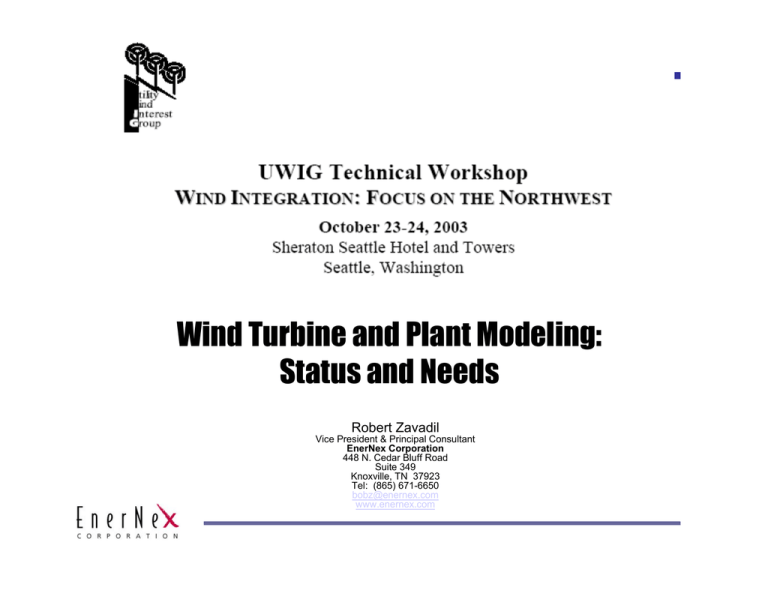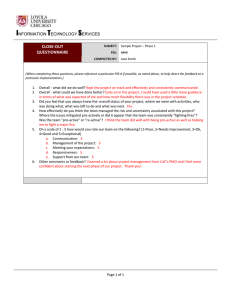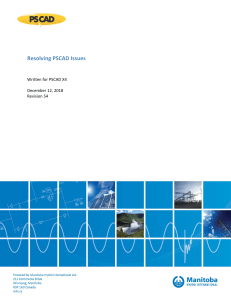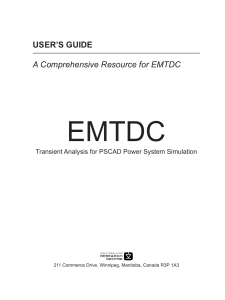Wind Turbine and Plant Modeling: Status and Needs
advertisement

Wind Turbine and Plant Modeling: Status and Needs Robert Zavadil Vice President & Principal Consultant EnerNex Corporation 448 N. Cedar Bluff Road Suite 349 Knoxville, TN 37923 Tel: (865) 671-6650 bobz@enernex.com www.enernex.com Why Models? Computer models used in all phase of power system engineering: ¾ ¾ ¾ ¾ ¾ Planning Design Maintenance and Operatios Assessment and Forensic or Root Cause Analysis Improvement and Enhancement Engineering recommendations are based on specific results for the system under consideration, not general rules Primary Technical Tools Power Flow ¾ Determines voltages, element loading for specified generation and deman ¾ Most basic power system engineering tool ¾ A variety of tools are used, but PSS/E and PSLF most common Dynamic Simulation ¾ ¾ ¾ ¾ Used to show how large power system moves from state to state Requires detailed models of dynamic elements Suitable for simulations of very large power systems PSS/E, PSLF are the standards fro U.S. transmission entities Electromagnetic Transients ¾ ¾ ¾ ¾ Detailed studies of electrical, mechanical, and control interactions Very detailed models of all power system elements Detailed nature of modeling prevents application to large power systems Examples: EMTP, ATP, PSCAD Important Studies for Wind Generation Power Flow Transfer Capability Transient Stability Dynamic Stability AGC/LFC/ED – Operations simulations Chronological Production Costing Specialized Studies (examples) ¾ Switching operations (cap bank switching, false breaker tripping) ¾ Sub-synchronous resonance ¾ Short-Circuit ERCOT Model Development Project - History Discussions of need for better wind plant models in system studies at least as far back as August, 2001 ¾ Ongoing issues with forced curtailment ¾ Recognition that curtailments have linkage to models Project scope developed in early 2002 RFP issued April, 2002 Project awarded June, 2002 Project kick off August 1, 2002 Project completion September, 2003 Project Objectives Develop models for four categories of commercial wind turbines appropriate for: ¾ ¾ ¾ ¾ Steady state analysis (power flow) Transient stability Small signal stability Stabilities studies including long and short-term dynamics Validate models with available event data from field measurements Document and deliver as “User Models” for PSS/E General Approach 1. Develop detailed models for individual wind turbines in PSCAD/EMTDC 2. Execute cases with detailed models and analyze results 3. Use simulation results to reduce the order of the turbine models for the types of events to be studied 4. Construct reduced-order models in PSS/E 5. Compare PSS/E and PSCAD/EMTDC results; refine models if necessary 6. Validate PSS/E models against field measurements GE Wind 1.5 MW – PSCAD/EMTDC Model Id BRK2 0.005 A Vrbc B G5 2 G3 L5 2 G5 0.005 Ed 0.005 C A S4 B S6 2 G4 L5 G2 2 G6 L3 L1 L3 L1 0.01 BRK3 Vrab G3 2 G1 25000.0 G1 BRK3 DCBK BRK2 DCBK Timed Breaker Logic Closed@t0 L2 2 G2 L2 L6 L6 L4 SBRK Icr Icrd RPM wm Iar Ibr G1 S5 S6 In2 Td TE G5 I2act wm G6 In1 Multimass ( IndM/c) TL Te Wpu I2cmd S3 Modulator w/ I1actInterpolation S4 wm G2 S2 G3 Gen-Side Ibrd Converter Icr Control I1cmd G4 Iard Torque Td Computer Tact Td * -1.0 0.001 Ilb 0.001 Ilc a b c IM Te Timed Breaker Logic Closed@t0 Icr Ics W Ibr Iar Iar Vrab Vrbc Iar S1 Ila L4 C Ias 0.001 A SBRK A Ias B Ibs C Ics B C TL N GE Wind 1.5 MW S tato r T erm inal V o ltage (L-G ) +3 V ta Ia s kV & kA +2 +1 Stator Current +0 -1 -2 -3 0 1 2 3 4 5 per-unit G enerato r S peed + 1 .3 + 1 .27 5 + 1 .25 + 1 .22 5 + 1 .2 + 1 .17 5 + 1 .15 + 1 .12 5 + 1 .1 + 1 .07 5 + 1 .05 + 1 .02 5 +1 0 wg p u Generator Speed 1 2 3 4 5 E lectro m agnetic T o rque per-unit +0 E M T o rq ue -0 .5 Generator Torque -1 -1 .5 0 1 2 3 4 5 R eal and R eactive P o wer O utput MW & MVAR +2 + 1 .6 P s tat Q s ta t + 1 .2 + 0 .8 + 0 .4 Generator Real & Reactive Power +0 -0 .4 -0 .8 -1 .2 -1 .6 -2 0 1 2 3 4 5 3 4 5 R o to r C urrent C o m m ands kA (Rotor Circuit) +1 + 0 .8 IR D D IR Q D + 0 .6 + 0 .4 + 0 .2 +0 -0 .2 -0 .4 -0 .6 -0 .8 -1 0 1 2 Tim e (s e c ) GE Wind 1.5 MW (cont.) Mechanical Torque +1 Tmech per unit +0.8 +0.6 Mechanical Torque +0.4 +0.2 +0 0 1 2 3 4 5 3 4 5 3 4 5 3 4 5 Blade Pitch +49 beta betastar PitchComp degrees +39 Blade Pitch +29 +19 +9 -1 0 1 2 Lambda (Tip-Speed Ratio) +12 lambda +9.6 +7.2 +4.8 +2.4 +0 0 1 2 Speed Error and Cp +0.4 Cp werr +0.3 +0.2 +0.1 +0 -0.1 0 1 2 Time (sec) PSCAD Results for Comparison w/ PSS/E Terminal Voltage +1.5 Real Power Generation Vrms +5 +1.4 +4.75 +1.3 +4.5 +1.2 +4.25 +1.1 +4 MVAR per unit +1 +3.75 +0.9 +3.5 +0.8 +3.25 +0.7 +3 +0.6 +2.75 +0.5 0 1 2 3 4 Pstat +2.5 0 5 1 Reactive Power Generation +4 Qstat +1.25 +3.5 +1.24 +3 +1.23 +2.5 +1.22 +2 +1.21 per-unit MVAR +1.5 +1.19 +0.5 +1.18 +0 +1.17 -0.5 +1.16 1 2 Time (sec) 3 4 5 3 4 5 3 4 5 wgpu +1.2 +1 -1 0 2 Rotor Speed +1.15 0 1 2 Time (sec) Prototype PSS/E Model Results Validation of ERCOT Dynamic Models Actual measurements are ultimate measure of model validity Quantities of interest ¾ Terminal characteristics – voltage current, P, Q ¾ Mechanical – speed, pitch ¾ Wind speed Challenges ¾ Both individual turbine and plant level measurements desirable for computer model validation ¾ Not feasible to collect both here due to budget and logistical constraints ¾ Individual turbine measurement data hard to come by, even from vendors Electrical data from interconnect bus best compromise in terms of value and cost Example Disturbance Data king42 King Mountain - 5/10/2003 10:03:06.524 Min(Va) Max(Va) Avg(Va) Min(Vb) Max(Vb) Avg(Vb) Min(Vc) Max(Vc) Avg(Vc) Min(Ia) Max(Ia) Avg(Ia) Min(Ib) Max(Ib) Avg(Ib) Min(Ic) Max(Ic) Avg(Ic) Voltage (%) 100 95 90 85 Current (A) 800 700 600 0 EPRI/Electrotek 1 2 3 4 5 6 Time (s) 7 8 9 10 11 PQView® Project Status 8 months of monitoring completed Detailed PSCAD and reduced-order PSS/E single turbine models completed for all 4 turbine types Analytical validation of PSS/E turbine models against detailed models completed for all 4 turbine types ERCOT wind plant models completed with finalization of TWPP remaining Plant model validation against measurements completed Presentation Ongoing Needs Model application expertise Continuing model validation Keeping up with new wind energy technology developments Addressing related issues ¾ Short-circuit behavior ¾ Advanced wind turbine technologies ¾ Advanced wind plant designs Looking ahead… Enlisting others in the process ¾ Other transmission providers, operators ¾ Turbine vendors / customers ¾ Industry working groups (e.g. IEEE PES) Addressing other power system engineering needs related to wind energy ¾ ¾ ¾ ¾ Short-circuit models Operations models Wind plant design Turbine and wind plant requirements/standards UWIG Role?





